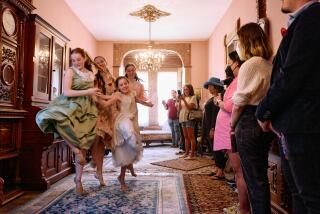The Kirov Premieres Its Unique Version of the Holiday Classic in Costa Mesa : A ‘NUTCRACKER’ BREAKS THE MOLD
- Share via
The “Nutcracker” ballet, which made its debut 100 years ago, has become a perennial holiday favorite. Dance Magazine estimates that more than 230 productions of the ballet will be danced in the United States alone this year, bringing in almost $46 million in box office revenues from more than 2 million customers.
Most of the productions descend from the version danced at the Maryinsky Theater in St. Petersburg in 1892. The Kirov Ballet, the direct descendant of the Maryinsky company, is dancing the American premiere of its “Nutcracker” production at the Orange County Performing Arts Center in Costa Mesa, through Sunday.
The Kirov is not dancing the original, however, but a version created by Vasili Vainonen in 1934. The first version, choreographed by Lev Ivanov, “was not a success, and it was a real tragedy for Tchaikovsky,” says Oleg Vinogradov, artistic director of the Kirov.
Vinogradov says the Ivanov version failed because the first two acts were performed by children and because Ivanov, who inherited the assignment after the great Marius Petipa fell ill, “did not have enough material to realize his ideas.”.
“It was a great pity that children danced two acts,” he says. “The choreography is not at a very high level because children’s possibilities are narrow. Only the last act and the Snowflakes Waltz were performed by the dancers, and it is just here that Ivanov reveals himself as a true choreographer of genius.”
Vainonen’s revision, however, has held the stage in Russia.
The Vainonen staging falls into three acts, with a full intermission before the Transformation Scene when Masha--as the young heroine is named in this production--falls asleep, sees the Christmas tree grow magically, helps the Nutcracker defeat the mice and departs with him through a snow storm to the Kingdom of the Sweets.
An intermission at this point will surprise most Western audiences, who are used to the music running on through all these events without a break. Vinogradov insists that the music comes to a full pause here, although perusal of a score published by Kalmus doesn’t bear this out.
According to Vinogradov, Vainonen was the first person to choreograph the mouse battle. “He organized it, and made it rhythmical,” he says. “There was too much pantomime in Ivanov’s version.”
Vainonen also introduced four extra cavaliers to assist the prince in the last act grand pas de deux with the Sugar Plum Fairy. Vinogradov considers the innovation “brilliant” because the four cavaliers constantly “raise the princess to the heights, and it seems as if she’s flying in the air. I think it’s wonderful.”
Missing from the list of characters in the divertissement, however, are Mother Ginger and the Pulichinelles. Vainonen simply didn’t use the music, and Vinogradov decided not to put it back in. “Then it would be my variation, not Vainonen’s,” he says. “I don’t see the necessity to make the change.”
More to Read
The biggest entertainment stories
Get our big stories about Hollywood, film, television, music, arts, culture and more right in your inbox as soon as they publish.
You may occasionally receive promotional content from the Los Angeles Times.










